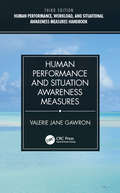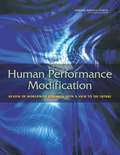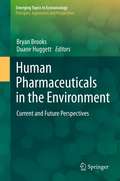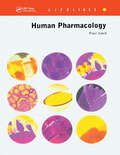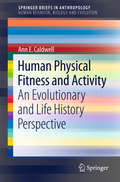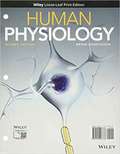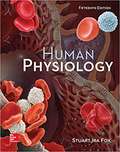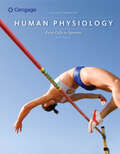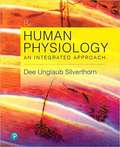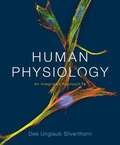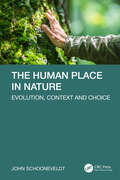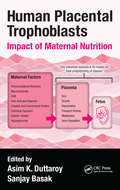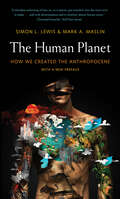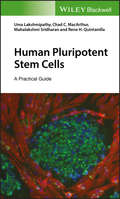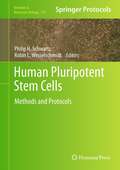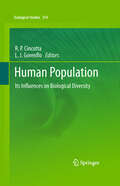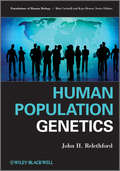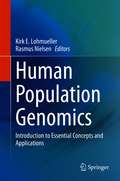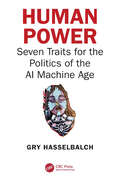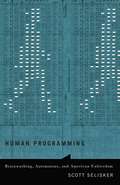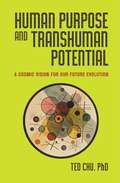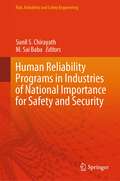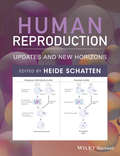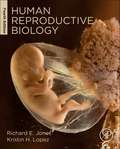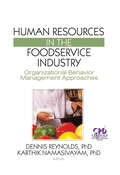- Table View
- List View
Human Performance and Situation Awareness Measures
by Valerie GawronThis book was developed to help researchers and practitioners select measures to be used in the evaluation of human/machine systems. The book begins with an overview of the steps involved in developing a test to measure human performance. This is followed by a definition of human performance and a review of human performance measures. Another section defines situational awareness with reviews of situational awareness measures. For both the performance and situational awareness sections, each measure is described, along with its strengths and limitations, data requirements, threshold values, and sources of further information. To make this reference easier to use, extensive author and subject indices are provided. <P><P>Features <li>Provides a short engineering tutorial on experimental design <li>Offers readily accessible information on human performance and situational awareness (SA) measures <li>Presents general description of the measure <li>Covers data collection, reduction, and analysis requirements <li>Details the strengths and limitations or restrictions of each measure, including proprietary rights or restrictions
Human Performance Modification
by Board on Behavioral, Cognitive, and Sensory Sciences Division of Behavioral and Social Sciences and Education National Research Council Division on Engineering and Physical Sciences Committee on Assessing Foreign Technology Development in Human Performance ModificationThe development of technologies to modify natural human physical and cognitive performance is one of increasing interest and concern, especially among military services that may be called on to defeat foreign powers with enhanced warfighter capabilities. Human performance modification (HPM) is a general term that can encompass actions ranging from the use of "natural" materials, such as caffeine or khat as a stimulant, to the application of nanotechnology as a drug delivery mechanism or in an invasive brain implant. Although the literature on HPM typically addresses methods that enhance performance, another possible focus is methods that degrade performance or negatively affect a military force's ability to fight. Advances in medicine, biology, electronics, and computation have enabled an increasingly sophisticated ability to modify the human body, and such innovations will undoubtedly be adopted by military forces, with potential consequences for both sides of the battle lines. Although some innovations may be developed for purely military applications, they are increasingly unlikely to remain exclusively in that sphere because of the globalization and internationalization of the commercial research base. Based on its review of the literature, the presentations it received and on its own expertise, the Committee on Assessing Foreign Technology Development in Human Performance Modification chose to focus on three general areas of HPM: human cognitive modification as a computational problem, human performance modification as a biological problem, and human performance modification as a function of the brain-computer interface. Human Performance Modification: Review of Worldwide Research with a View to the Future summarizes these findings.
Human Pharmaceuticals in the Environment
by Bryan W. Brooks Duane B. HuggettHuman interaction with the environment remains one of the most pervasive facets of modern society. In a world characterized by rapid population growth, unprecedented global trade and digital communications, energy security, natural resource scarcities, climatic changes and environmental quality, emerging diseases and public health, biodiversity and habitat modifications are routinely touted by the popular press as they canvas global political agendas and scholarly endeavors.
Human Pharmacology
by Paul R. GardPharmacology, in its own right, is a massive subject area and has been the focus of several major textbooks. Human Pharmacology is a readable, introductory text covering all of the main aspects of pharmacology in a way that enthuses the reader to study the subject further. Each chapter includes line drawings and figures to illustrate concepts and m
Human Physical Fitness and Activity
by Ann E. CaldwellThe science of human physical activity and fitness is ripefor a novel theoretical framework that can integrate the ecological, genetic,physiological and psychological factors that influence physical activity inhumans. Physical inactivity dominates most developed nations around theworld, and is among the leading causes of disease burden and death worldwide. Despitethe wide array of physical and mental health benefits, few people get therecommended level of physical activity to achieve these benefits. Currentresearch on physical activity has not, as of yet, been successful for thedevelopment of effective exercise interventions. Several researchers haveadvocated a more integrative approach that takes evolutionary history intoaccount, but such a framework has yet to be advanced. To that aim, the firstgoal of this book is to present a comprehensive evolutionary and life historyframework that highlights the domain-specific aspects of the evolved psychologyand physiology that can lead to a more integrated and complete understanding ofphysical activity across the lifespan. It summarizes and extends previous workthat has been done to understand the ways natural selection has shaped physicalactivity in humans in traditional and modern economies and environments. In many ways, humans are adaptedto be physically active. Overall, however, natural selection has shaped aflexible, but energy conscious system that responds to environmental andindividual costs and benefits of physical activity to optimally allocate afinite energetic budget across the lifespan. This system is adapted to respondto cues of resource scarcity and high levels of obligatory physical activity, andconserves energy to favor allocation in ways that increase the likelihood ofreproductive success and survival. This nuanced application leads to a morethorough understanding of the circumstances that natural selection is predictedto favor both sedentary and active behaviors in predictable ways across thelifespan. The second goal of this book is to synthesizeand interpret cross-disciplinary research (from biological and evolutionaryanthropology and psychology; epidemiology; health psychology; and exercisephysiology) that can illuminate original approaches to increase physicalactivity in modern, primarily sedentary contexts. This includes a breakdown ofthe human lifespan to discuss the predicted costs and benefits of physicalactivity at each stage of life in order to differentiate the obstacles tophysical activity and exercise that are functionally adaptive--or were in theenvironments that they evolved--and identifying which factors are moremodifiable than others in order to develop interventions and environments thatare more conducive to physical activity. Normal 0 false false false EN-US JA X-NONE /* Style Definitions */ table. MsoNormalTable {{mso-style-name:"Table Normal"; mso-tstyle-rowband-size:0; mso-tstyle-colband-size:0; mso-style-noshow:yes; mso-style-priority:99; mso-style-parent:""; mso-padding-alt:0in 5. 4pt 0in 5. 4pt; mso-para-margin-top:0in; mso-para-margin-right:0in; mso-para-margin-bottom:10. 0pt; mso-para-margin-left:0in; line-height:115%; mso-pagination:widow-orphan; font-size:11. 0pt; font-family:"Calibri","sans-serif"; mso-ascii-font-family:Calibri; mso-ascii-theme-font:minor-latin; mso-hansi-font-family:Calibri; mso-hansi-theme-font:minor-latin; mso-bidi-font-family:"Times New Roman"; mso-bidi-theme-font:minor-bidi;}}
Human Physiology
by Bryan H. DerricksonThe 2nd edition of Human Physiology is an integrated solution to the challenges students encounter when enrolled in a Human Physiology course. Incorporating digital and print content, this program supports students’ understanding of core physiological concepts while building the critical thinking skills that will prepare them for success in their future careers. Critical thinking exercises help students apply their knowledge of physiology by asking them to address real-life situations and guiding them through the logical progression of thought processes needed to answer them.
Human Physiology
by Stuart Ira Fox Krista Rompolski#1 selling text with great explanations and just enough anatomy!Clear explanations and a solid learning framework have been market tested and refined. Fox helps students master the fundamentals by providing appropriate anatomical detail.Human Physiology Fifteenth Edition is intended for the one-semester Human Physiology course often taken by allied health and biology students. The beginning chapters introduce basic chemical and biological concepts to provide students with the framework they need to comprehend physiological principles. The chapters that follow promote conceptual understanding rather than rote memorization of facts. Health applications are included throughout the book to heighten interest deepen understanding of physiological concepts and help students relate the material to their individual career goals. Every effort has been made to help students integrate related concepts and understand the relationships between anatomical structures and their functions.
Human Physiology: From Cells to Systems (MindTap Course List)
by Lauralee SherwoodOrganized around the central theme of homeostasis--how the body meets changing demands while maintaining the internal constancy necessary for all cells and organs to function--HUMAN PHYSIOLOGY helps you appreciate the integrated functioning of the human body. Author Lauralee Sherwood uses clear, straightforward language, analogies, and frequent references to everyday experiences to help you learn and relate to physiology concepts. The vibrant art program and empowering digital resources--including robust 3D animations and rich homework problems --enable you to visualize important concepts and processes. By focusing on the core principles and sharing enthusiasm for the subject matter, Sherwood helps you develop a solid foundation for future courses and careers in the health profession.
Human Physiology: An Integrated Approach
by Dee SilverthornHuman Physiology: An Integrated Approach is the #1 best-selling 1-semester human physiology text world-wide. The 8th Edition engages students in developing a deeper understanding of human physiology by guiding them to think critically and equipping them to solve real-world problems. Updates, such as new Try It activities and detailed teaching suggestions in the new Ready-to-Go Teaching Modules, help students learn and apply mapping skills, graphing skills, and data interpretation skills. The text reflects Dr. Silverthorn’s active learning style of instruction, and builds upon the thorough integration of “big picture” themes with up-to-date cellular and molecular physiology topics that have always been the foundation of her approach. Mastering A&P features new Interactive Physiology 2.0 tutorials, new Try It! Coaching Activities, and Phys in Action! Video Tutors, complementing Human Physiology and providing a cohesive learning experience for today’s learners.
Human Physiology: An Integrated Approach
by Dee Unglaub SilverthornHuman Physiology: An Integrated Approach has thorough coverage of molecular physiology seamlessly integrated into a traditional homeostasis-based systems approach.
The Human Place in Nature: Evolution, Context and Choice
by null John SchooneveldtThis book explores a new approach to understanding the evolution of mind and consciousness by examining the perceptual abilities of animals and the way they experience their world. It offers a science-based bottom-up approach to our own conscious worldview by seeing it through the eyes of others. Emphasis is on the role of context in evolution and the way animals internalize and engage with the contextual properties of their world that are meaningful for them. The core argument is that a context, which is subjective and comprised of the perceptual capacities, offers new insights into the evolution of mind. Rather than seeing biological evolution in terms of the emergence of mindless forms and cultural evolution as the emergence of disembodied minds, the book seeks to integrate these two perspectives through the rigorous mapping of contexts.Key Features Reveals an understanding of animal minds Formulates a hypothesis for the evolution of consciousness Includes a discussion of the origin of technological innovation Provides a rationale for the ecology of mind Proposes a theory of the evolution of language Outlines the science of experience and how it influences choice Explains the role of context and choice with respect especially to human ecology
Human Placental Trophoblasts: Impact of Maternal Nutrition
by Asim K. Duttaroy Sanjay BasakHuman Placental Trophoblasts: Impact of Maternal Nutrition explores the vital roles of trophoblasts play in fetal growth and pregnancy, giving you new insight into the modulation of placental trophoblast functions by nutrients. It also reviews the role of fatty acids, folic acids, and specific vitamins in this aspect. The book highlights the critic
The Human Planet: How We Created the Anthropocene
by Simon L. Lewis Mark A. MaslinAn exploration of the Anthropocene and “a relentless reckoning of how we, as a species, got ourselves into the mess we’re in today” (The Wall Street Journal).Meteorites, mega-volcanoes, and plate tectonics—the old forces of nature—have transformed Earth for millions of years. They are now joined by a new geological force—humans. Our actions have driven Earth into a new geological epoch, the Anthropocene. For the first time in our home planet's 4.5-billion-year history a single species is increasingly dictating Earth’s future.To some the Anthropocene symbolizes a future of superlative control of our environment. To others it is the height of hubris, the illusion of our mastery over nature. Whatever your view, just below the surface of this odd-sounding scientific word—the Anthropocene—is a heady mix of science, philosophy, history, and politics linked to our deepest fears and utopian visions.Tracing our environmental impacts through time, scientists Simon Lewis and Mark Maslin reveal a new view of human history and a new outlook for the future of humanity in the unstable world we have created.
Human Pluripotent Stem Cells: A Practical Guide
by Uma Lakshmipathy Chad C. MacArthur Mahalakshmi Sridharan Rene H. QuintanillaComprehensive coverage of the entire induced pluripotent stem cell basic work flow Pluripotent stem cells (PSC) can divide indefinitely, self-renew, and can differentiate to functionally reconstitute almost any cell in the normal developmental pathway, given the right conditions. This comprehensive book, which was developed from a training course, covers all of the PSCs (embryonic, embryonic germ, and embryonic carcinoma) and their functions. It demonstrates the feeder-dependent and feeder-free culture of hESC and hiPSC, which will be referred to in all protocols as PSCs. It also addresses the methods commonly used to determine pluripotency, as defined by self-renewal marker expression and differentiation potential. Human Pluripotent Stem Cells: A Practical Guide offers in-depth chapter coverage of introduction to stem cell, PSC culture, reprogramming, differentiation, PSC characterization, and more. It also includes four appendixes containing information on reagents, medias, and solutions; common antibodies; consumable and equipment; and logs and forms. Includes helpful tips and tricks that are normally omitted from regular research papers Features useful images to support the technical aspects and results visually as well as diagrammatic illustrations Presents specific sections (ie: reprogramming, differentiation) in a concise and easily digestible manner Written by experts with extensive experience in stem cell technologies Human Pluripotent Stem Cells: A Practical Guide is an ideal text for stem cell researchers, including principal investigators, and others in university and industry settings, and for new graduate students in PSC labs.
Human Pluripotent Stem Cells
by Philip H. Schwartz Robin L. WesselschmidtAlmost daily, new technologies are being presented that move the field of human pluripotent stem cell research towards a future that may yield highly-effective, personalized medical treatments. Three enabling technologies at hand for human PSCs are 1) directed reprogramming of somatic cells, which eliminate many of the ethical issues associated with the derivation and use of human PSCs, increase genetic diversity of the available human PSC lines, and give rise to better in vitro human disease models; 2) the discovery that a Rho-associated protein Kinase (ROCK) inhibitor allows for efficient single cell passaging and cryopreservation, increasing the efficiency and reliability of hPSC culture; and 3) defined, animal-component-free media, which lay the groundwork for simplified scale-up for therapeutic applications, differentiation protocols, and toxicology screens. The aforementioned technologies can be found in Human Pluripotent Stem Cells: Methods and Protocols, a compilation of 33 detailed protocols in six categories of PSC research that cover laboratory essentials and the derivation of new PSC lines, including induced PSC lines, as well as their growth, maintenance, characterization, genetic manipulation, and differentiation. Written in the successful Methods in Molecular BiologyTM series format, chapters include introductions to their respective topics, lists of the necessary materials and reagents, step-by-step, readily reproducible protocols, and notes on troubleshooting and avoiding known pitfalls. Authoritative and accessible, Human Pluripotent Stem Cells: Methods and Protocols serves as an ideal guide to scientists conducting their own pluripotent cell research programs and makes great strides towards furthering human knowledge and, ultimately, improving the human condition.
Human Population
by Richard P. Cincotta Larry J. GorenfloIn this volume the dynamic patterns of human density and distribution are examined in relation to the viability of native species and the integrity of their habitats. Social, biological, and earth scientists describe their models, outline their conclusions from field studies, and review the contributions of other scientists whose work is essential to this field. The book starts with general theories and broad empirical relationships that help explain dramatic changes in the patterns of the occurrence of species, changes that have developed in parallel with human population growth, migration and settlement. In the following chapters specific biomes and ecosystems are highlighted as the context for human interactions with other species. A discussion of the key themes and findings covered rounds out the volume. All in all, the work presents our species, Homo sapiens, as what we truly have been and will likely remain--an influential, and often the most influential, constituent in nearly every major ecosystem on Earth.
Human Population Genetics (Foundation of Human Biology #7)
by John H. RelethfordIntroductory guide to human population genetics and microevolutionary theory Providing an introduction to mathematical population genetics, Human Population Genetics gives basic background on the mechanisms of human microevolution. This text combines mathematics, biology, and anthropology and is best suited for advanced undergraduate and graduate study. Thorough and accessible, Human Population Genetics presents concepts and methods of population genetics specific to human population study, utilizing uncomplicated mathematics like high school algebra and basic concepts of probability to explain theories central to the field. By describing changes in the frequency of genetic variants from one generation to the next, this book hones in on the mathematical basis of evolutionary theory. Human Population Genetics includes: Helpful formulae for learning ease Graphs and analogies that make basic points and relate the evolutionary process to mathematical ideas Glossary terms marked in boldface within the book the first time they appear In-text citations that act as reference points for further research Exemplary case studies Topics such as Hardy-Weinberg equilibrium, inbreeding, mutation, genetic drift, natural selection, and gene flow Human Population Genetics solidifies knowledge learned in introductory biological anthropology or biology courses and makes it applicable to genetic study. NOTE: errata for the first edition can be found at the author's website: http://employees.oneonta.edu/relethjh/HPG/errata.pdf
Human Population Genomics: Introduction to Essential Concepts and Applications
by Kirk E. Lohmueller Rasmus NielsenThis textbook provides a concise introduction and useful overview of the field of human population genomics, making the highly technical and contemporary aspects more accessible to students and researchers from various fields. Over the past decade, there has been a deluge of genetic variation data from the entire genome of individuals from many populations. These data have allowed an unprecedented look at human history and how natural selection has impacted humans during this journey. Simultaneously, there have been increased efforts to determine how genetic variation affects complex traits in humans. Due to technological and methodological advances, progress has been made at determining the architecture of complex traits. Split in three parts, the book starts with the basics, followed by more advanced and current research. The first part provides an introduction to essential concepts in population genetics, which are relevant for any organism. The second part covers the genetics of complex traits in humans. The third part focuses on applying these techniques and concepts to genetic variation data to learn about demographic history and natural selection in humans. This new textbook aims to serve as a gateway to modern human population genetics research for those new to the field. It provides an indispensable resource for students, researchers and practitioners from disparate areas of expertise.
Human Power: Seven Traits for the Politics of the AI Machine Age
by Gry HasselbalchThe rapid and tumultuous technological transformation of our societies has triggered a self-exploratory public debate about what it means to be human. What are our human potential, talents, and powers – what, essentially, is our place in the modern world? Will a culture of machines out-compete a culture of humanity?In this thought-provoking but ultimately hopeful book, scholar and leading technology critic Gry Hasselbalch invites readers to reflect on the shifting dynamics between humans and the AI-powered technologies increasingly shaping our world. Exploring the distinctiveness of human power, the book addresses current debates about technology that portray humans as powerless and flawed – in essence outdated software in dire need of a technological fix – arguing that human power must remain central in discussions about AI and technology. It investigates seven key traits which set humans apart from machines: Creativity, Intuition, Emotion, Life, Defiance, Love, and Wisdom. Drawing on interviews and examples from across arts – including literature, visual arts, film and music – and from technology politics and policymaking, Human Power explains how these traits provide a foundation for a new politics in the AI Machine Age. One that does not diminish and reduce human power, but actively protects and reinforces it.If human power is not a computational process, then what is it? Human Power: Seven Traits for the Politics of the AI Machine Age gives human power – our humanity and fundamental “humanness” – a renewed voice in a debate dominated by fears and preconceptions about technological power. This important new work will appeal to journalists, policymakers, artists, and educators—and anyone else interested in the rapidly growing role of AI and digital technology in our lives.
Human Programming: Brainwashing, Automatons, and American Unfreedom
by Scott SeliskerDo our ways of talking about contemporary terrorism have a history in the science, technology, and culture of the Cold War? Human Programming explores this history in a groundbreaking work that draws connections across decades and throughout American culture, high and low. Scott Selisker argues that literary, cinematic, and scientific representations of the programmed mind have long shaped conversations in U.S. political culture about freedom and unfreedom, and about democracy and its enemies. Selisker demonstrates how American conceptions of freedom and of humanity have changed in tandem with developments in science and technology, including media technology, cybernetics, behaviorist psychology, and sociology. Since World War II, propagandists, scientists, and creative artists have adapted visions of human programmability as they sought to imagine the psychological manipulation and institutional controls that could produce the inscrutable subjects of totalitarian states, cults, and terrorist cells. At the same time, writers across the political spectrum reimagined ideals of American freedom, democracy, and diversity by way of contrast with these posthuman specters of mental unfreedom. Images of such &“human automatons&” circulated in popular films, trials, travelogues, and the news media, giving form to the nebulous enemies of the postwar and contemporary United States: totalitarianism, communism, total institutions, cult extremism, and fundamentalist terrorism. Ranging from discussions of The Manchurian Candidate and cyberpunk science fiction to the cases of Patty Hearst and the &“American Taliban&” John Walker Lindh, Human Programming opens new ways of understanding the intertwined roles of literature, film, science, and technology in American culture.
Human Purpose and Transhuman Potential: A Cosmic Vision for Our Future Evolution
by Ted Chu[from inside flaps] ""Today we stand at a new frontier. We have within our sight--if not yet within our reach--a radically new human freedom. It is the freedom from our inborn genetic condition--the liberation from the constraints of our biological form.... The human era as we have known it is coming to an end. The posthuman era is about to begin." So writes Ted Chu, in this magisterial treatment of the increasingly timely debate about transhumanism and the meaning and purpose of human evolution. A prominent macroeconomist and polymath, Chu offers the most systematic effort yet to explore the scientific, historical, ethical, and philosophical dimensions of this worldwide discussion, reframing a field too often disfigured by scientific reductionism. Chu immediately establishes an interdisciplinary and evolutionary stance and then examines the ongoing transhumanist project from a rich variety of perspectives. He goes on to articulate a goal for humanity in the face of technological breakthroughs that beckon us toward previously unimagined potentials for progress--that is, if we can find the courage to consciously manage our own evolution. A new understanding of transhumanism emerges as he plumbs the depths of the world's wisdom traditions and surveys the most cutting-edge evolutionary theories and scientific advances. While admitting that the pursuit of human happiness is appropriate and noble, Chu demonstrates why our ultimate purpose--our "new divine covenant"--is to serve the forward march of cosmic evolution through the transcendence of our own biology, thus making way for our evolutionary successors in the posthuman future."
Human Reliability Programs in Industries of National Importance for Safety and Security (Risk, Reliability and Safety Engineering)
by Sunil S. Chirayath M. Sai BabaThis book discusses human reliability programs (HRPs) and their various elements, including safety and security case studies. The topics covered include significance and vulnerability aspects of human reliability and sustainable HRP, including case studies and lessons learned, methodologies used for human reliability analysis, and good practices of HRPs from various industries. Human reliability is widely used in fields requiring high standards of safety, such as the aviation, petroleum and chemical process, and nuclear industries. The book showcases contributions on the topic from experts in the field of technology, design, aviation, and nuclear industries. The book can be a valuable reference for researchers and professionals interested in HRP to ensure safety and security in industries.
Human Reproduction: Updates and New Horizons
by Heide SchattenIn vitro fertilization (IVF) and other assisted reproductive technologies (ART) have become a significant part of human reproduction, with already one in 50 children worldwide being born through ART and the demand steadily increasing. To accommodate the various kinds of infertility problems, new methods have been developed to increase IVF and ART success rates and it has also become possible to treat sperm, eggs, and embryos in culture to improve reproductive success, to increase the health state of an embryo, and to prevent disease in the developing child. Human Reproduction: Updates and New Horizons focuses on recent developments and new approaches to study egg and sperm cells and embryo development, as well as addressing the increasing demand for IVF and ART to overcome infertility problems of various kinds that are encountered by an increasing number of couples worldwide. The book includes 10 chapters written by experts in their specific fields to provide information on sperm selection techniques and their relevance to ART; In vitro maturation of human oocytes: current practices and future promises; Molecular biology of endometriosis; Novel immunological aspects for the treatment of age-induced ovarian and testicular infertility, other functional diseases, and early and advanced cancer immunotherapy; Mitochondrial manipulation for infertility treatment and disease prevention; Novel imaging techniques to assess gametes and preimplantation embryos; Clinical application of methods to select in vitro fertilized embryos; New horizons/developments in time-lapse morphokinetic analysis of mammalian embryos; The non-human primate model for early human development; Cytoskeletal functions, defects, and dysfunctions affecting human fertilization and embryo development. This book will appeal to a large interdisciplinary audience, including researchers from both the basic science and medical communities. It will be a valuable reference for IVF clinicians, patients and prospective patients who are considering ART procedures, embryologists, cell biologists and students in the field of reproduction.
Human Reproductive Biology, 4th Edition
by Kristin H. Lopez Richard E. JonesThe fourth edition of Human Reproductive Biology-winner of a 2015 Textbook Excellence Award (Texty) from The Text and Academic Authors Association-emphasizes the biological and biomedical aspects of human reproduction, explains advances in reproductive science and discusses the choices and concerns of today. Generously illustrated in full color, the text provides current information about human reproductive anatomy and physiology. This expansive text covers the full range of topics in human reproduction, from the biology of male and female systems to conception, pregnancy, labor and birth. It goes on to cover issues in fertility and its control, population growth and family planning, induced abortion and sexually transmitted diseases. This is the ideal book for courses on human reproductive biology, with chapter introductions, sidebars on related topics, chapter summaries and suggestions for further reading. Winner of a 2015 Texty Award from the Text and Academic Authors Association Beautifully redrawn full-color illustrations complement completely updated material with the latest research results, and clear, logical presentation of topics Covers the basic science of reproduction-endocrinology, anatomy, physiology, development, function and senescence of the reproductive system-as well as applied aspects including contraception, infertility and diseases of the reproductive system New companion website features full-color illustrations as PPT and jpeg files for both professors and students to use for study and presentations
Human Resources in the Foodservice Industry: Organizational Behavior Management Approaches
by Dennis Reynolds Karthikeyan NamasivayamGet up-to-date research and innovative management strategiesOrganizational behavior and human resource management are fundamental aspects in the profitability of any foodservice business. Human Resources in the Foodservice Industry: Organizational Behavior Management Approaches examines the latest research critical in understanding indi
